I bought yet another car back in June, this one entirely on impulse. I paid about $2,000, plus a whole ton of other money, to purchase and ship a 1998 MGF from Japan. Now, my new-to-me British roadster is finally home, and I’m stoked because the car is in far better shape than I expected. The icing on the cake: this roadster, which was once the best-selling car of its class in Britain (yes, I bought a British car from Japan), is actually really awesome. I knew I was getting a top-down car, but what I actually got is even better.
I seem to be going through a car importation extravaganza this year. I started off the madness back in March by purchasing a 1997 Honda Life for just $258 through Japanese auctions. Then I spent about another $4,000 importing the car and repairing its ills. I am quite happy with my tiny car, and it’s proof that you can still get really awesome cars in Japan for not a whole lot of coin. Not even America’s tariffs were able to sully my experience.
I also had a ton of fun importing my car. Everything was thrilling, from tracking my car’s Ro-Ro ship, the MOL Clover Ace, across the Pacific Ocean, to driving to the port to pick it up. Importing a car is easily one of the coolest things an American enthusiast can experience, and if you’re crazy like me, you might not want to deal with an American dealership again.
A Teenage Dream

Unfortunately for my bank account, this means that my hankering for car imports did not extinguish after the acquisition of my Honda. The beast had to be fed again. As luck would have it, I spotted a car that I had been looking for a long time, a MGF. I’ve long been a fan of Mazda Miata alternatives like the Saturn Sky Red Line and the Toyota MR2, but one car that has kept my curiosity since my teenage years was the MGF.
Back then, I was a huge fan of the British motoring shows. Top Gear had me hooked for the production value and entertainment, Fifth Gear reeled me in with its tests, reviews, and, admittedly, a crush I had on one of the show’s presenters. Fifth Gear was the show behind the famous “Smart Fortwo vs. jersey barrio” test. Fifth Gear also tested the cute little cars that I often didn’t see the three Top Gear blokes touching!
I soon found myself obsessing over the little MGF and its sequel, the MGTF. Now, before we continue, I’ve seen these cars described as “Rover MGF,” “MG MGF,” “MG F,” and “MGTF.” My MGF was registered in Japan as a “Rover MGF” and a product of Rover Japan. However, the official UK brochures that I have access to spell out the earlier version of this roadster as “MGF” and the later one as “MG TF.” That’s how I will as well.
Anyway, this MG is the fourth car that I’ve imported from Japan. Now, you might wonder why I decided to import a British car from Japan, and the answer is quite simple. I’ve noticed that the few MGFs for sale in America often have prices around $7,000 or so, so buying one that’s already here was out. Likewise, I’ve noticed that ones in good condition in the UK are about a few grand, but then I’d have to pay money on top of that to have someone buy it for me and arrange for shipping to America. All of this is on top of paying more because the dollar is weaker than the pound.

However, it’s much easier to buy a car like this from Japan. The MGF was sold new in Japan, so there is a supply of them that you can buy. The yen is also weaker than the dollar, and Japan also has a strong export industry already in place that makes buying a car as easy as placing an order on DoorDash.
In my case, I saw what would become my MGF on the car marketplace Be Forward. The car looked great in the photos, and the documentation provided suggested that it was a solid car that just had a couple of cosmetic troubles. The site told me that I could have my MGF delivered to Baltimore for the total price of $4,080 before Customs clearance. That’s the price of the car plus land shipping, ocean shipping, freight insurance, documents, and all of the other odds and ends that need to be completed in Japan.

The car that would become my MGF was easily the cheapest MGF currently for sale in Japan that didn’t have a ruined suspension, a dying engine, wrecked paint, or a torn convertible top. But, look, I’m trying to be responsible. I had only just purchased an imported car! Logically, I shouldn’t have bought another car, but my fingers clearly don’t work on the same logic that my brain does, because they definitely hit Buy Now.
So, now the car is finally here. What did I get?
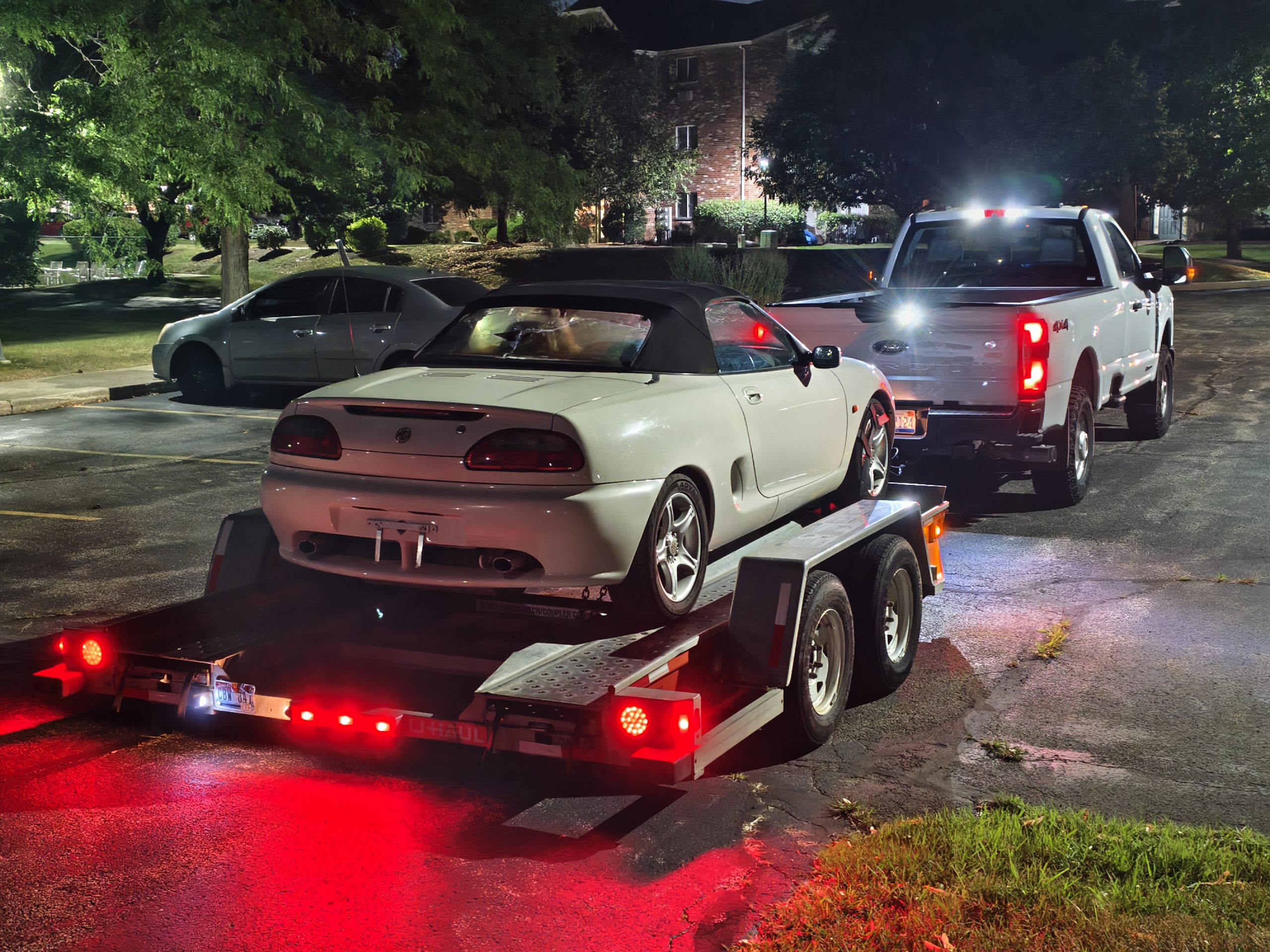
MG’s First New Car In Decades
According to the MGF register, the MGF was a huge deal for MG. This roadster wasn’t just a new car; when it launched in 1995, it was MG’s first all-new car in 32 years.
As AROnline writes, the MG of the 1980s found itself in a bit of a pickle. The brand, which fell under the large umbrella of British Leyland, saw the closure of its famed Abingdon factory in October 1980. The last car to be produced there was the MGB, and at the time, there was no direct successor. MG would survive by selling hopped-up versions of Austin Rover saloons and keep itself on the minds of enthusiasts through motorsports.
However, as AROnline noted, MG brass knew that it needed a convertible to secure its future. After all, convertibles are what MG was known for at the time! MG decided to reboot itself. It wasn’t just going to create a new car, but demonstrate MG’s engineering prowess with a sports car with slick aerodynamics, sharp design, and forward-thinking technology. This would go on display as the MG EX-E concept, which looked like no other MG in history.
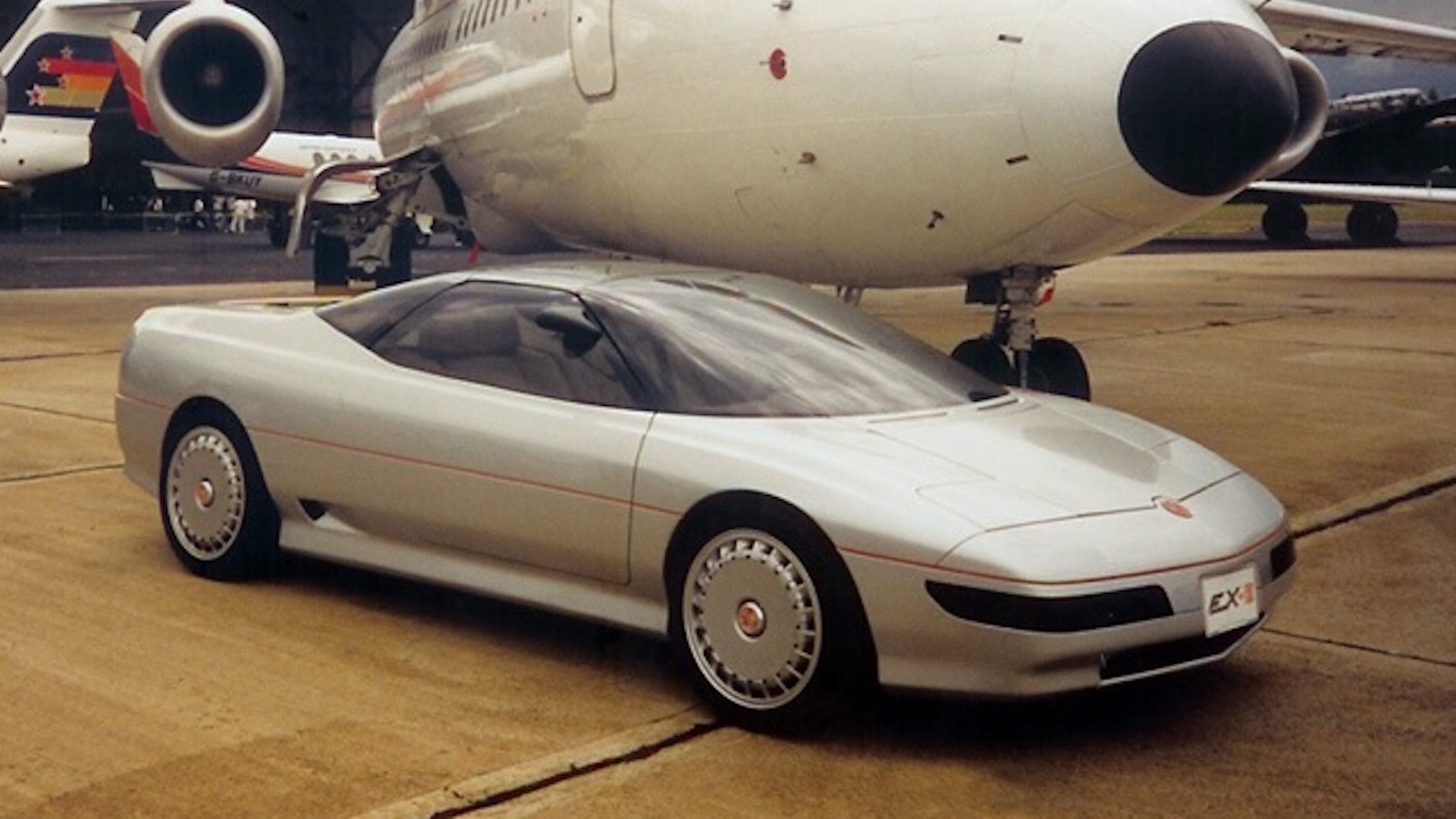
The MG EX-E had a coefficient of drag of just 0.24, a 250 HP MG Metro 6R4 engine, four-wheel-drive, and a bonded aluminum chassis with plastic panels. Reportedly, MG public relations suggested that the EX-E could have been a production vehicle, but it remained a concept.
Later on in the 1980s, MG would produce the MG F-16 concept. This car looked more realistic than the MG EX-E and featured a front engine, front-wheel-drive layout. Reportedly, this car’s development stalled out due to company finances, poor sedan sales, and government influence. Rover never gave the project the full green light.
AROnline notes that the pivotal moment for MGF development happened at the end of the 1980s, when Rover Group was sold to British Aerospace in 1988. By 1989, Rover was back into a better financial shape, too. But the real turning point came thanks to Mazda, which launched the MX-5 Miata. Suddenly, Rover brass had tangible proof that roadsters were in, and finally gave the green light to make a successor to the MGB.
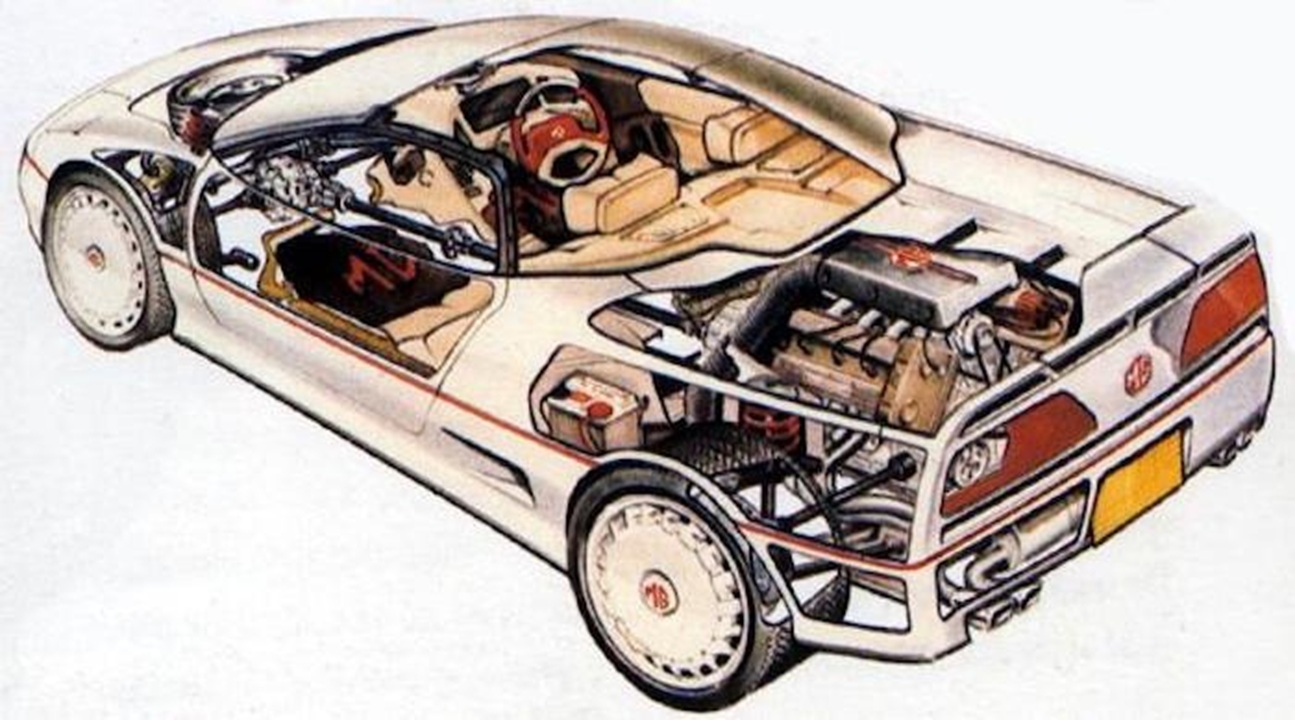
AROnline continues:
The final piece of the MGF jigsaw was the formation of Rover Special Products. The raison d’etre of this division was simply to take on Rover Group projects that were considered too marginal for the mainstream Design Teams to consider working on. RSP was manna from heaven for the new MG, simply because it allowed for much in the way of flexibility during the design process without actually taking too many resources away from the mainstream design team, which was busy working on upcoming Rover saloons and hatchbacks.
As a result, the project was given some direction, and a commitment to production looked much more likely. An overall designation of, ‘Phoenix Revival’ (or ‘Phoenix Route’) was assigned, and in an exercise to work out what was the best route to follow in devising the new car, three subsequent MG convertible prototypes would be given PR designations.
Under the direction of Rover Special Projects division, the PR3 project was designed and developed by Steve Harper, during the first months of 1991. The design theme, inspired by the TWR XJR15, was first sketched in the January of 1991, and then developed over the next month, in which time, the distinct shape of the MGF was soon established. Full-size clay modelling began in March, and the ‘red car’ was first shown to Rover management that same month.
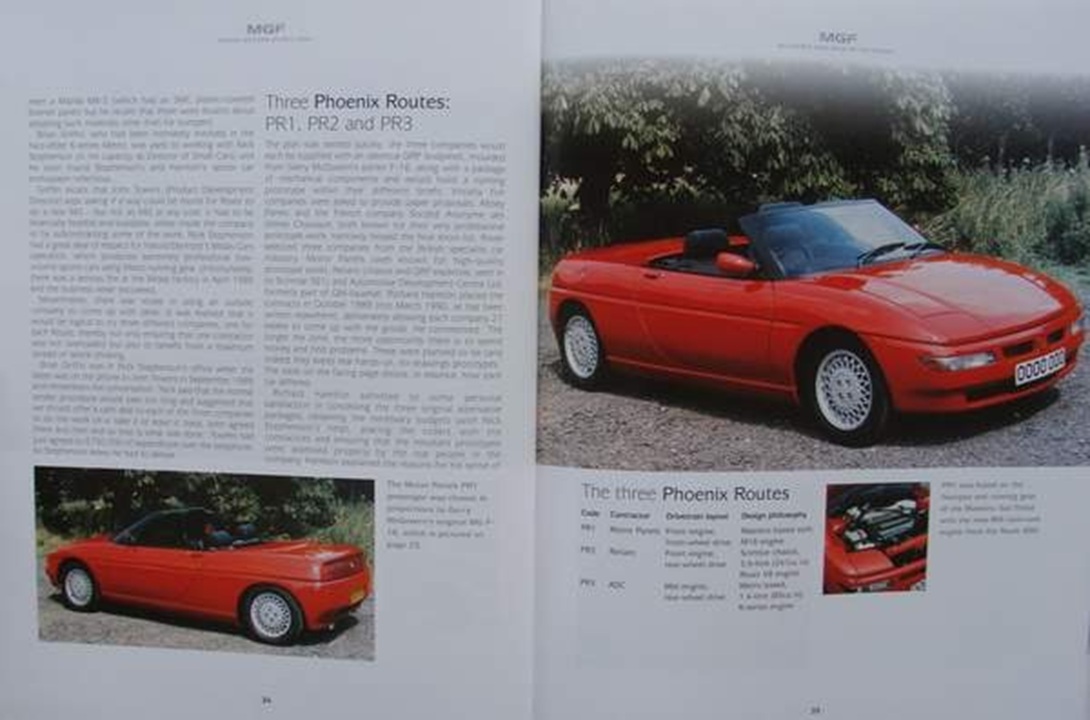
Three prototypes were produced by Motor Panels, Reliant, and ADC, respectively. One had a front engine, front-wheel-drive setup like the F-16, one had a front engine and rear-wheel-drive, and the third had a mid-rear engine and rear-wheel-drive.
The front-wheel-drive prototype was canned because, while it reportedly handled well, it relied on the floorpan of the Austin Maestro, and thus, was based on old technology.
The front-engine, rear-wheel-drive car was thrilling with its 3.9-liter engine, but would have required an entirely new platform and drivetrain. But the mid-rear car could use an existing powertrain, but shoved into the rear of the car. Besides, reportedly, the mid-rear car had superior behavior on the road, anyway.
The MGF Gets The Green Light

With the layout locked in, the team then turned to ironing out the visuals, and commissioned proposals from three studios. Once the design was locked in, the engineering team went pretty nuts. From AROnline:
So, thanks to Rover’s insistence that the PR3 was to be as British as bangers and mash, it was heart warming to see that the Rover parts bin was raided – and no Honda at all crept into the design, a temptation for any Rover Engineer during the early 1990s. There was only one choice for the power unit: the K-Series engine, but surprising for observers, the suspension used was Dr Alex Moulton’s Hydragas – hardly an obvious choice, given the cars in which it was previously used. But Hydragas worked especially well with the mid-engined MG because it could be tuned specifically to provide accurate response during direction changes, without being too nervy. As Alex Moulton related in Autocar magazine at the launch of the MGF, ‘it de-fidgets the car” because of its best property – the front/rear connection. Being short of wheelbase, the car was potentially very susceptible to becoming unsettled on rough surfaces – but the interconnected MG suffered far less than its rivals.
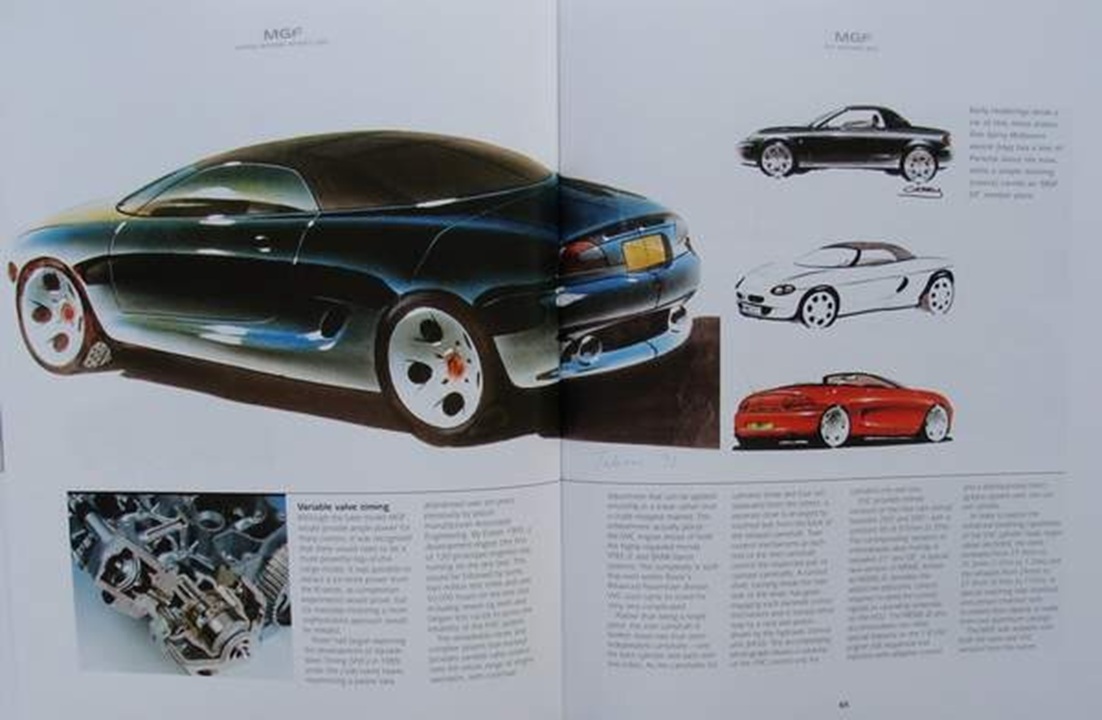
The 1.8-litre version of the K-Series engine is an engine that was never originally designed for a mid-engined installation. As has been relayed elsewhere, the K-Series engine was an optimised package for use in small and medium-sized hatchbacks – and, as a result, it was an extremely compact power unit.
However, Rover Group Powertrain was faced with the pressing need to replace the bought-in Honda 1.6-litre engines – and, because of this need, the big block K-Series was born. Some very ingenious engineering solutions were employed to squeeze extra capacity from the K-Series engine, chief of these were new cylinder liners, called damp liners, which allowed an increased cylinder size by fitting bigger bores into the same block size. The result was four cylinders squeezed into the same size block – a longer throw crankshaft effected the enlargement from 1.6 to 1.8-litres. Continuing Rover’s loaves and fishes reputation, the entire budget for the engine programme was, ‘less than £200 million’.

The MGF finally hit the road in March 1995, and it largely blew everyone away. Here was the first all-new MG in over three decades, and it was all British. MG was rewarded with strong sales, and the MGF eventually became Britain’s best-selling convertible. This distinction seemed to be well-earned, too. Autocar said, via AROnline:
‘It would have been so easy for Rover to stick an MG badge on the nose of a mediocre car and once more rely on the marque’s image to do the selling. This has not happened. Rover has instead created what is, in all probability, the world’s most complete and affordable open two-seater. From traditional MG fans to those wanting something more stylish than the chopped-about hatchbacks that pass for convertibles these days, the MGF should prove a blessing. It is an all-British car of which we can be unusually proud.’

As far as AROnline was concerned, the MGF is a competitor of the Miata, though more for the driver who likes driving to the bar and hanging out with their friends rather than hitting the track like a Miata pilot.
Despite the MGF’s success in its home market, the roadster never crossed the Atlantic to battle the Miata in America. Rover Group fell into the hands of BMW back in 1994. Reportedly, BMW cited homologation costs as one reason why the MGF never made it over here. AROnline writes that BMW also must not have been in a rush to launch the MGF here in America, where it would compete with BMW’s own Z3.

Thankfully, the MGF has been legal to import into America since 2020. So, BMW might not have wanted you to have one, but now you can have one, anyway.
My MGF

It sounds like I might have found a diamond in the rough. My car went through a Japanese auction before ending up on the Be Forward platform. The Japanese auction inspection sheet for my car indicated a car with 15,982 kilometers, or 9,930 miles. However, the auction sheet also noted that the mileage was not actual due to a cluster replacement. Since getting the car, I found an oil change sticker stating the car had an oil change done at just under 18,000 kilometers in the summer of 2020. So, the car definitely had a cluster with more kilometers on it in the past. The clutch and brake pedals aren’t very worn, and neither is the steering wheel. While I have not been able to confirm the car’s mileage, I’d be willing to bet that it has well under 100,000 miles.




Mileage isn’t something I care that much about, anyway. You can have a low-mile car that’s a piece of junk and a high-mile car that’s pristine. So I cared more about the overall condition. The condition sheet said that the car had a valid inspection until June 2026. The sheet also noted leather seats, functional air-conditioning, and an overall grade of 4, with the exterior and interior both earning C grades. The car also had an independent inspection with the only negative note being a small engine oil leak.
I noticed that the car had an intact, but clearly worn-out, convertible top window in its auction pictures. After the auction, the car was parked in the yard and it looks like someone opened the roof without unzipping the rear window. As a result, the old and brittle plastic window, which was probably original to the car, broke apart.

Based on my own inspection, some water did get in. This water left behind stains and perhaps some surface-level corrosion on the car’s seat frames, but the car otherwise dodged a bullet. Thankfully, someone at the yard thought about water ingress and taped up the window. Surprisingly, this kept water out!
As you can probably guess from my photos, I have already replaced the window. Don’t worry, I’ll write about that surprisingly easy process.

Aside from the broken window, the car came as described. The engine purred, the transmission clicked and locked into gear with ease, and as the Japanese auction claimed, it really did have ice-cold air-conditioning. For the first time since starting my car importation journey back in 2021, I finally imported a car that doesn’t need any mechanical work!
The rest of the car was in impressive shape to me. The paint on this car is even better than the paint on my Honda Life. I couldn’t find any real rust to speak of, the tires were in great shape, and I couldn’t find a single electrical problem. I mean, when was the last time you’ve seen plastic headlights that looked this good on a 27-year-old car?

What really surprised me was the drive. Now, I haven’t driven this car very far yet, but I am impressed with what I’ve experienced thus far. The cockpit and driving position of the MGF do remind me of a Miata, but everything is just a bit weird.
The weirdness starts with the keys, which are shaped like the MG logo and have a pivot on the key blade. They’re awesomely stylish. I’m so used to the plain keys you get with most other cars, and yet these keys have a surprising amount of detail for something you won’t be looking at for very long. My car came with both keys, plus both immobilizer remotes. I didn’t even know the MGF had a remote-operated security system!
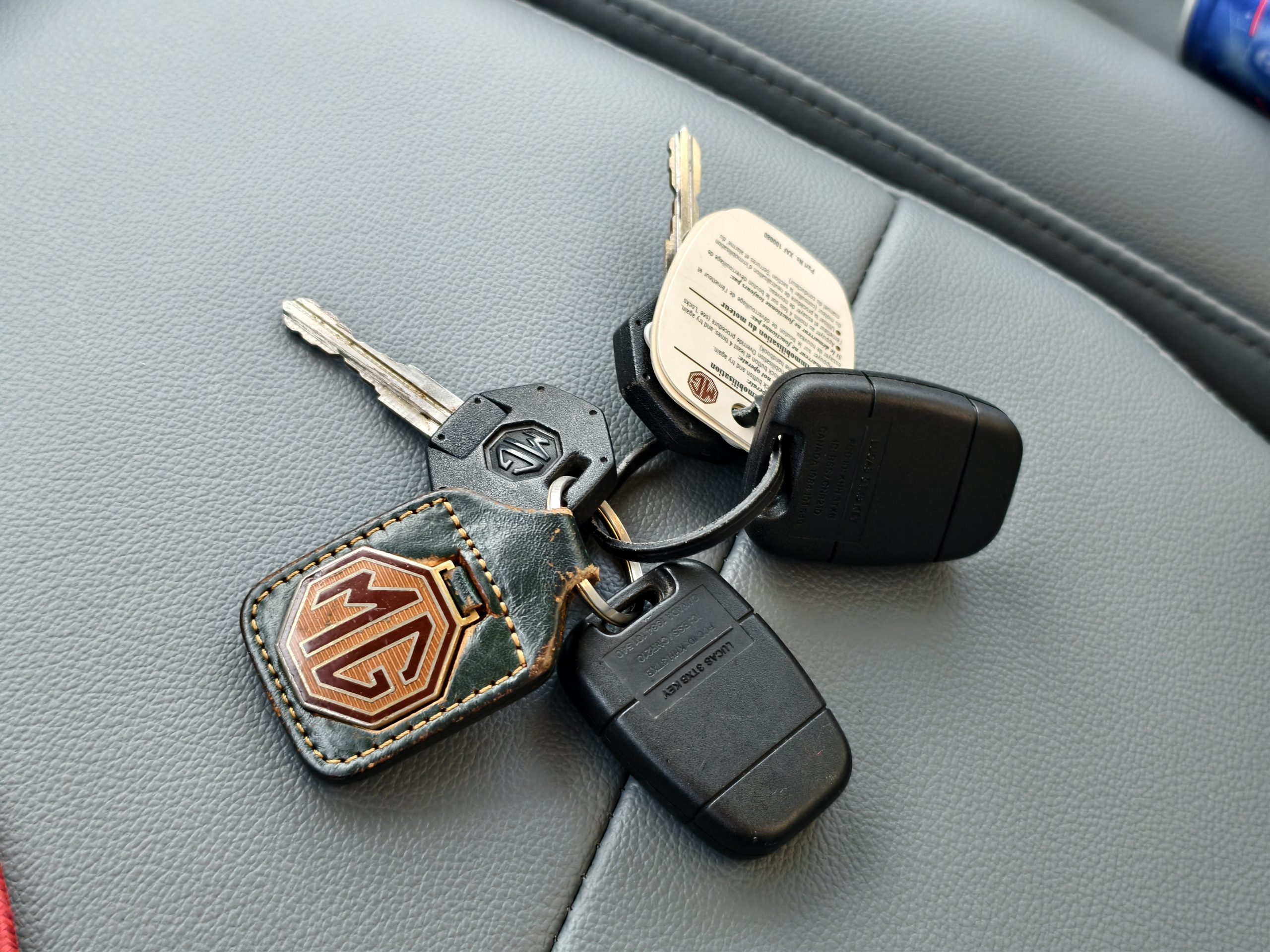
Once I hopped in, I slid one of the keys into the illuminated ignition barrel and turned. The early MGF came equipped with a 1.8-liter Rover K-Series inline four good for 118 HP. My car has the hotter 1.8-liter K-Series VVC engine, which has variable valve timing and 143 HP.
This engine sounds vaguely like a washing machine, except for when I let off the throttle. Then, I get a few growls from the exhaust pipes, which make me smile. What I really like is that the engine is pretty lively, especially above 2,000 RPM. It’s not so much fast as it’s engaging. Allegedly, these VVC cars will hit 60 mph in about 7 seconds. That’s about a touch slower than an original Audi TT, or a touch slower than a GM front-wheel-drive boat with a 3800 supercharged V6. That’s not a dig on the MGF! In classic British roadster fashion, it’s not all about straight-line speed.


I haven’t been able to test the handling extensively just yet, but I’m definitely buying into the hype of the hydragas suspension. I wrote a couple of paragraphs about the suspension in the past:
What is a Hydragas suspension? Instead of separate springs and dampers, you get space-saving displacers filled with an inert gas. It’s a successor to the Hydrolastic suspension designed by British engineer Alex Moulton. In this system, conventional springs and shock absorbers are replaced with a liquid-based suspension system meant to reduce pitch and keep a vehicle level on bumps.
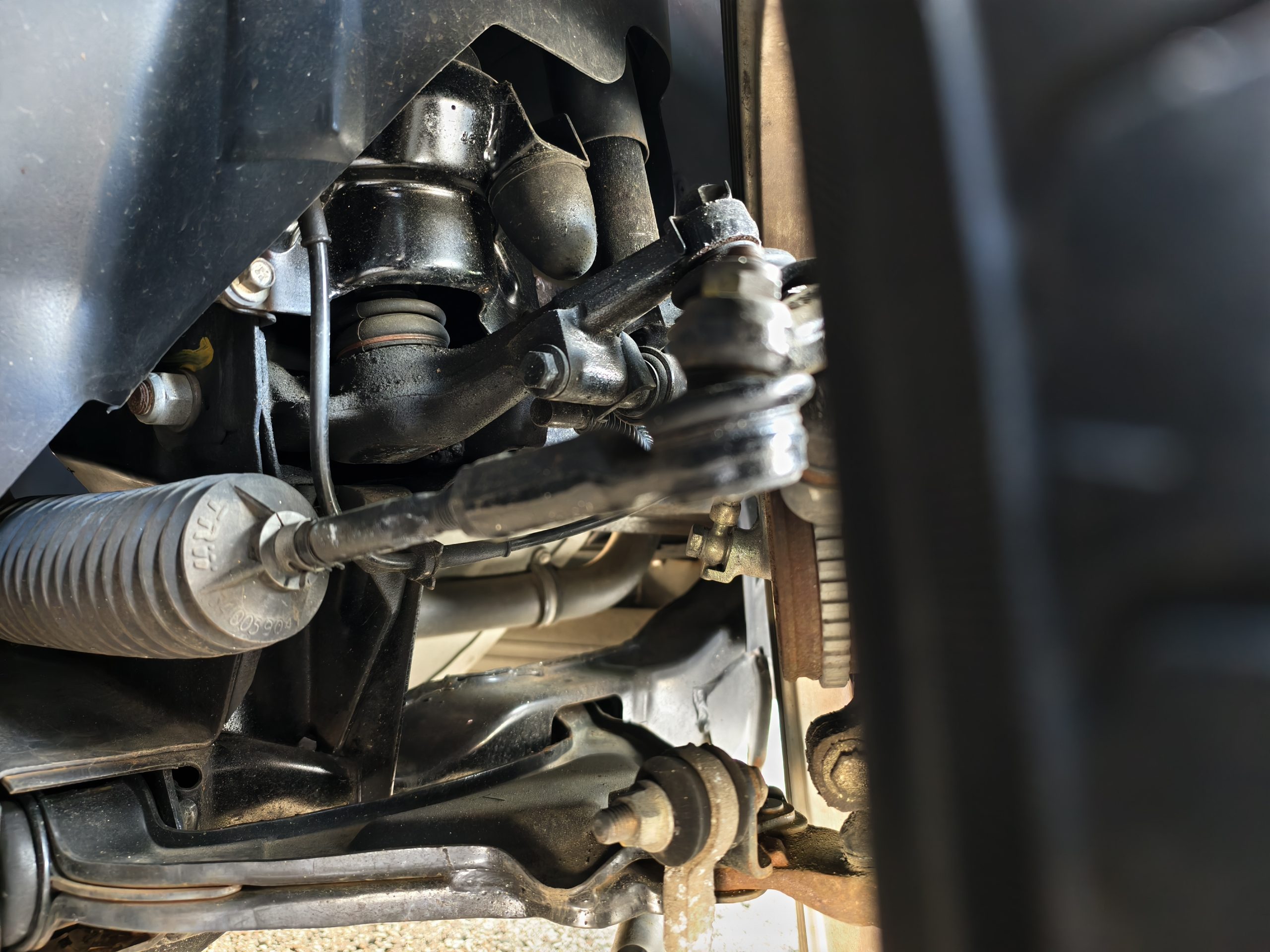

Each unit consists of a damper unit and a Hydragas displacer, an integral spring that uses compressed nitrogen as the springing medium. As a reader once explained, the main difference between the Hydrolastic system and Hydragas is that the Hydrolastic system used displacers featuring a rubber spring.
According to the documentation I’ve found online, my MGF’s ride height is a little too low, which MG groups say can be rectified by pumping up the Hydragas suspension. As it turns out, that process is doable for the DIY wrencher! But I haven’t gotten around to that just yet. Still, even with my suspension in its somewhat reduced performance state, the suspension lives up to the promise of reducing pitch. My car likes to fly straight and level like a Cessna 172 with the trim set just right. The Hydragas soaks up bumps relatively well, too. This is still a low-slung sporty car, so it’s not going to be a Cadillac. But the car didn’t feel like it was going to fall apart after it hit its first Midwest pothole.
I also love the instrumentation. I have everything I might want to look at here, including my coolant temperature and oil temperature. I’m so used to owning cars that use lights to warn you about abnormal temperatures, so it’s nice to have some physical gauges again.

The car has additional quirks because it’s a British car that was sold new in Japan. Much of the interior is in English, aside from the safety warnings on the sunvisors. Also, even though this car was sold new in Japan, it doesn’t have Japan’s common turn signal layout. In a Japanese car, the right stalk actuates the headlights and turn signals. This car has its turn signal and headlight stalk on the left side, like you would get in a left-hand drive car.
I’m In Love, Again
The best way I could describe this little car is that it’s like what would happen if someone made a weird Toyota MR2, or put a Miata through a British translation filter. The MGF is different, cute, and a whole lot of fun.


So, the MGF is definitely going into my secret warehouse of favorite cars after I fix a couple of its cosmetic troubles. All in, I’ve paid around $5,200 total for this car, and that includes the new convertible window that I recently installed. That’s not bad to have a unique car to cruise around in for the summer. Even cooler is that, because my car has a 17-digit VIN, most states, even the ones that hate Kei cars, will have no problem slapping a license plate on it.
Once again, I arrive at the same conclusion I had earlier this summer. If you’re looking for a fun and weird car without having to spend a lot of money, look to Japan. The exchange rates will be in your favor, and if you choose a car that’s not a legend, there are still some great deals to be had out there, even in this age of tariffs and strained trade relations. Not only can you get a cool car, but you’ll have a great time importing it, too!






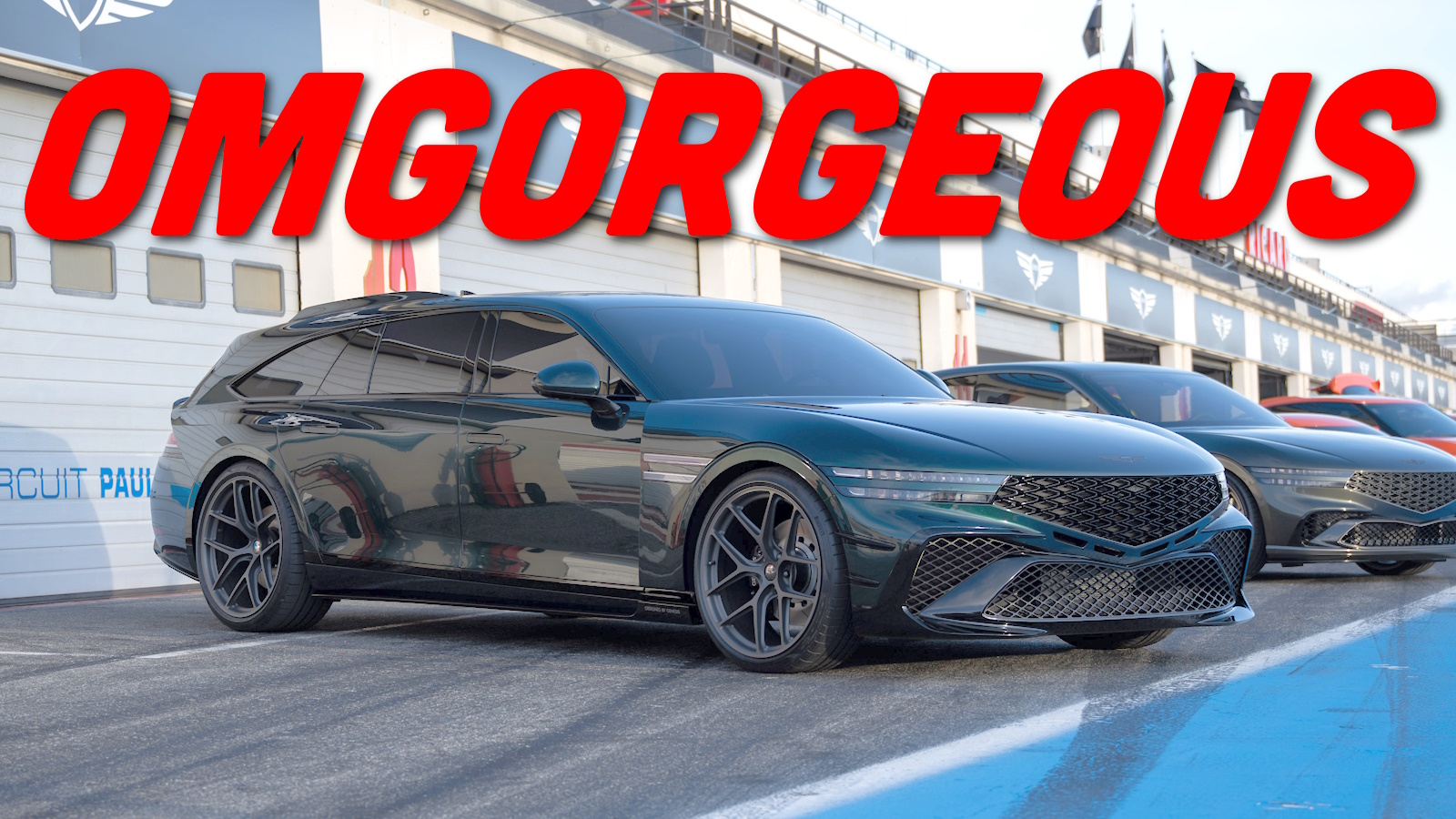


Congratulations, I’ve always had a soft spot for this car. Can’t wait to hear more about it.
That EX-E concept looks remarkably like a BMW Nazca C2 (but way worse), and actually predates it by about 5 years. I had to check to see if Italdesign was involved.
If memory serves the EX-E was designed by my uncle Gerry.
If it had been shown on schedule in Geneva in 1984, it would have been even further ahead of its time and had more than a year in the sun.
British Disease, or something, delayed it until Frankfurt in 1985, and it was a star until one month later, when GM showed the Buick Wildcat Concept at SEMA, then the Corvette Indy in Detroit in January. Both wildly unrealistic, but wild, and they sucked away all the publicity from the EX-E.
The British car industry shoots itself in foot shocker.
Should I call you 2WiperF?
Congrats on the MG! Seems like you got a good one!
Congrats on the new whip- cool car! I’m still shocked that you have ~15 cars and live in an apartment!? I know you got stash places etc but…. You are the person who needs, deserves? a barndominium. Ditch the rent and storage $ and it might be close. Convince Beau to kick the dealio into gear. Could be a sweet meet up spot too for future content. I’m in your corner!
Be like Dirk Pitt and get yourself an old airplane hanger. Build you an apartment along the back wall and stick all your planes, trains, and automobiles in there.
^^^this guy is correct
Lotus used the K-Series in the Elise at first as well. This has to be one of the most-fitted mid-engine motors then.
The suspension is easy to pump up. For about $150.00 you can get a pump rig and you can mix your own suspension juice.
Awesome, so you already got it registered?
About the time these were new, there was an amusingly named Australian alternative band called “Machine Gin Felatio”. For obvious reasons, they often simply shortened their name to their initials, “MGF”. These cars, to me at least, will always be Machine Gun Felatios. I was a newly licenced driver when these came out and lusted after them. I very rarely see any about these days and those that I do look pretty forlorn.
Even if the engine blew up today, you still got a damned good deal for this car.
I don’t think a lot of enthusiasts really understand what you have. This car had a 50/50 weight distribution from the factory. With such a lot mass, it will be able to hold its own with an Elise in the corners.
Meant to say, “low” mass.
The Elise will leave it at the curb.
Tiff Nidell complained about the understeer at 85MPH… I would imagine that a set of good, sticky tires with carefully set PSI would make quite a bit of difference there. It does appear to have a rear weight bias with the engine and gearbox in the back and just a spare tire and battery in the front. If you don’t plan on driving 85MPH around the bends, then there should not be any problems.
Again, the tires are paramount. Old, dried rubber slides all over the place, and cheap tires do so as well. Investing in good tires pays back in confidence, safety and driving satisfaction.
Great write up, can’t believe these “new” MGs are that old. I drove 60s MGs, Triumphs and Austin Healeys in the 70s and 80s, and they were not as old as the MGF is now.
I was waiting for this! I have two ’90s era Rovers here in Detroit — and they GREAT cars. One is a 1993 Rover 220 Tomcat and the other is a 1999 Rover 75.
My next car will be an MGTF — one version is now legal to import.
If you look at the latest Show & Display list, you will the 2004 TF 80th Anniversary car can legally come over.
As soon as there’s room in my garage, I’ll bring one over.
That car doesn’t have hydragas. That is just something I don’t want to mess with.
Thanks, Mercedes! I was so interested in seeing your opinion of the MG.
The 220 Tomcat was the best car Rover ever built imo. Still looks good today and keeps up with anything that’s not electric.
The 75 comes with a slight whiff of retirement home and toffee in tins but it’s also a good car with a very relaxed (and especially British) ambience. The Mustang’s V8 though: I have a suspicion these engines fell off the back of a shipping container, but you could get, and still can if you can find one, a Rover 75 wagon with a 4.6 Mustang engine. Someone was baking ‘special muffins’ at Rover the day that was conceived…
Hang on to that Tomcat. It’s hen’s teeth these days and very, very rare.
The Rover 75 is on my list of cars I have an entirely irrational deep desire for.
It was the car I promised myself when I was learning to drive, and I got one! It’s been my daily drive for 14 years and 170,000 miles. Mine is the absolute poverty spec (smallest engine, cloth trim) and it still feels special inside. And of all the mid sized euro saloons of the period (I drove most of them at the time) it was the nicest-riding out of all of them.
You will not be disappointed.
It is very Audi like in terms of road feel. It’s nicer than a Jag on the inside. The V-6 with a manual, which is what I have, delivers pretty snappy performance.
But really it’s the styling that just really stands out.
Not a bad line on it, no angle that doesn’t look pleasing.
Huge pilfering of the BMW/Mini parts bin makes maintenance somewhat easier. We got the engine here in the Freelander, so parts are here.
I also have a 2012 Mini Cooper, and you can see BMW’s strategy with Rover and Mini. Both cars feel like they are from the same company.
That looks like a hell of a fun car for that price! I’m not even sure you can find a comparable Miata for that price now and you won’t see ten of these every day.
So, how long until we get to see it sporting it’s Racing Modification livery?
https://static.wikia.nocookie.net/gran-turismo/images/7/78/-R-MGF_1.8i_VVC_%2795.jpg
Cool car I drove one once at a track instruction day. Instructor said the handling could be quite variable from car to car as it was a bit random how the suspension was setup even from the factory.
As others have said head gaskets are a common issue.
These are fantastic little budget boulevard cars. We had one for about four years and the only thing that went wrong with it was one electric window. Which then randomly fixed itself after I’d ordered and paid for a new wiring kit.
The Rover K-Series is notorious for head gasket failure, partly due to its design and partly due to deterioration of the the cooling system itself over time; hoses, bottles, caps, all of it. If any part of the cooling system looks original I’d change it out now for new parts before it gets expensive.
SAIC used the same engine in their MG7 (a surprisingly good looking Audi A5 copycat – https://en.wikipedia.org/wiki/MG7) but they upgraded the gaskets, head bolts and various other gubbins which cured the problem. I doubt you’ll find the SAIC kit at home, but it wouldn’t cost a lot to get it from the UK where it’s readily available and I *highly* recommend it. Fit this and never worry about gaskets again.
Good ones are £4k to £5k here in the UK and I think those prices might start creeping up. Great buy!
This is now my favorite car of yours. I’m glad to hear there were no shenanigans getting home safely from the port!
Looking forward to hearing more about it!
The wife has a ’77 MGB that we tool around in during the summer.
Wow, I’m in Japan and I’ve actually never seen one of those here, but you know what I do see? Mitsuoka’s! There has to be a Mitsuoka in your future!
Congrats! I believe the original Mini used suspension like that; I had a 72 for a while. Most fun car I’ve ever owned. 38hp lol
It’s wild that your most reliable car is a ~30 year old British car!
… hasn’t experienced the pending issues to come quite yet. Future storylines.
You’ve done well there – it looks like a lovely example!
But was it big in Japan, alright?
What a fabulous car!! Congratulations 🙂
Didn’t want to use Honda parts… put in a British K series.
This thing needs a Honda K series swap
Why? The Rover K series is a really rather clever piece of engineering – I’m sure Mercedes will go to town on the novel construction of the motor at some point – and in the highest performance version (fitted to certain models of early Lotus Elise and derivatives) it made 189hp – which is a higher specific output than the Type R Hondas of the same time period, and achieved at lower revs to boot.
In the highest performance spec the Rover K made less horsepower than an Integra Type R with the same displacement and was no longer even a road car engine. You paid Lotus a significant premium to hand-modify your engine for competition use with no emissions certification and kit car status. The actual street version of the VHPD K-Series, fitted to the S1 Exige and the 340R, made do with 177 horsepower instead; putting it right in line with the engine from an Integra GSR (but at higher RPM than a B18C). I’m sure if Honda was willing to sell factory modified Integras with no catalytic converters or powertrain warranties for off road use they could have put out Type Rs with more than the 195hp that a DC2 made in Japan and the United States.
It’s still an impressive engine, its VVC system was pretty trick vs other variable valve timing systems at the time, and an S1 by no means would benefit from a K20/K24 swap the way a 2ZZ Elise does; but it doesn’t need to be talked up beyond what it actually was.
It was a little different here in the UK – The Type R Integra had 187hp here and the fastest Exige 189. The Exige was Euro 4 compliant with that motor too.
https://www.parkers.co.uk/lotus/exige/coupe-2004/super-sport-2d/specs/
The Exige S2 with 189 horsepower was Euro 4 compliant with that motor because “that motor” wasn’t a Rover K. It was a 2ZZ-GE.
I’m making myself look like a complete arse here, aren’t I?
You are of course right and I’m wrong – that was the wrong Lotus, and I’m sorry.
Here’s Chris Harris talking about the right one though.
https://www.youtube.com/live/p14NM_HwM0I
No particular reason other than the history of the partnership and the engine block having the same code.
Looking forward to more write-ups about this little car!
Repair articles pending.
That’s a cute little car – and seems like you really lucked out with the condition.
Well done!